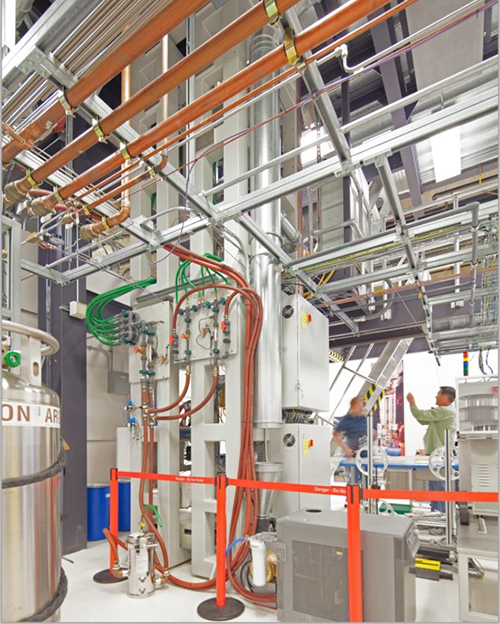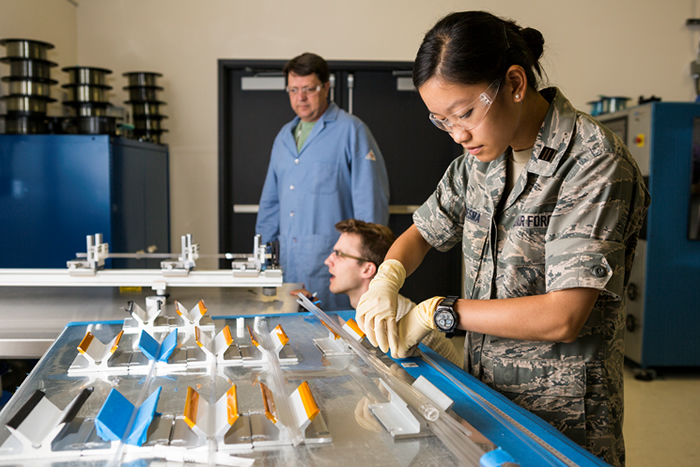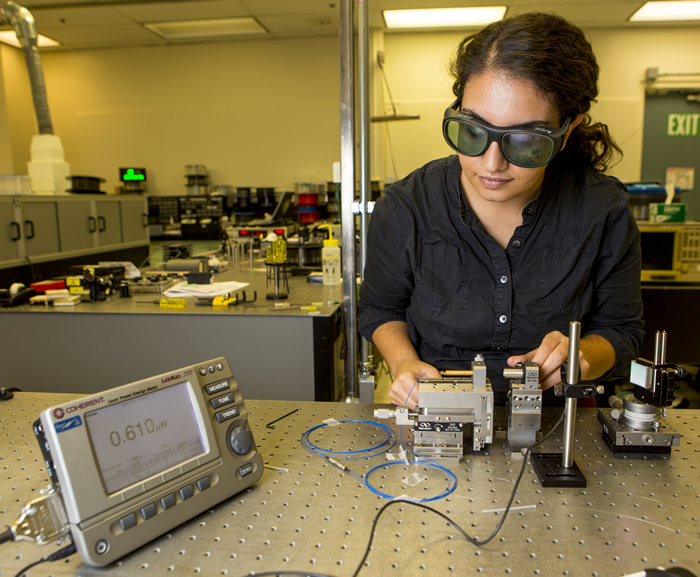Fiber Lasers

Putting Optical Fibers to Work
Fiber lasers are a class of lasers that use optical fibers doped with rare-earth minerals as the gain medium. They are robust, easy to use, and reliable. Optical fibers are always in alignment and excel at generating high average power with excellent beam quality.
 A technician makes an adjustment to LLNL’s fiber draw tower. The tower can draw optical fibers ranging from 80 to 500 microns in diameter.
A technician makes an adjustment to LLNL’s fiber draw tower. The tower can draw optical fibers ranging from 80 to 500 microns in diameter. Industrial fiber-based lasers harness the power from many laser diodes—each diode generating roughly one watt of power—to generate single 100-watt to 1,000-watt beams that can, in a flash, cut steel, weld ships, or inscribe a logo onto a carbon fiber part.
Military-grade fiber lasers go a step further, forming so-called diffraction-limited beams that can be tightly focused over hundreds of meters, allowing them to better engage remote targets. Arrays of diffraction-limited lasers can also be combined into single diffraction-limited beams to increase the total power to many tens of kilowatts, sufficient to engage mortars, drones, and missiles (see DoD Technologies.)
Our team is unusual in that it combines an in-house optical fiber fabrication facility with LLNL’s expertise in high-power and high-pulse-energy lasers, such as the 2-megajoule laser that drives the National Ignition Facility. Commissioned in 2011, the optical fiber fabrication facility includes a dedicated cleanroom for assembling low-defect stack-and-draw preforms and a fiber draw tower for pulling the preforms into solid or hollow fibers.
With appropriate safeguards, fiber lasers can be operated by turning a key or touching a screen. NIF & Photon Science researchers are extending the capabilities of fiber lasers by developing high average-power pulsed lasers that may become important for scientific applications such as laser-based particle accelerators.
Throughout these efforts, LLNL has teamed with partners in the government and private sectors. Joint research efforts with the Lasers and Optics Research Center at the U.S. Air Force Academy resulted in codes that can calculate the thermal and nonlinear limits of fiber structures running on high-performance computers operated by the armed services and federally-funded research centers.
 Air Force ROTC cadet Celine Ledesma (right), a NIF&PS Summer Scholar, works with Reggie Drachenberg (kneeling) and Nick Schenkel on hollow-core fibers in the fiber draw tower lab. Ledesma is assembling a stack-and-draw preform, an early step in the process of creating a fiber laser.
Air Force ROTC cadet Celine Ledesma (right), a NIF&PS Summer Scholar, works with Reggie Drachenberg (kneeling) and Nick Schenkel on hollow-core fibers in the fiber draw tower lab. Ledesma is assembling a stack-and-draw preform, an early step in the process of creating a fiber laser. An intriguing spinoff of the laser efforts has been the invention of a new fiber-based amplifier that could double the information-carrying capacity—that is, the bandwidth—of the internet, an advance that has gained the attention of telecom companies and venture capitalists.
 NIF & Photon Science postdoctoral researcher Leily Kiani tests a new optical fiber that could double the bandwidth of fiber-optic cables. Credit: Jason Laurea
NIF & Photon Science postdoctoral researcher Leily Kiani tests a new optical fiber that could double the bandwidth of fiber-optic cables. Credit: Jason Laurea More Information
“NIF&PS Delivers a Fiber-based Sodium Laser Guide Star,” NIF & Photon Science News, December, 2018
“Two Key Honors Boost Lab’s E-band Fiber Optic Amplifier,” NIF & Photon Science News, September, 2018
“A Laser Focus on Fiber-optic Upgrades,” NIF & Photon Science News, September, 2018
“Scientists Take Aim at ‘Eye-Safer’ Lasers,” NIF & Photon Science News, February, 2018
“LLNL’s Optical Fibers Contribute to New Undersea Communications Technology,” NIF & Photon Science News, October, 2017
“Increasing Carrying Capacity of Fiber-Optic Cables,” NIF & Photon Science News, December, 2016
“New Optical Fiber Both Polarizes and Amplifies,” NIF & Photon Science News, October, 2016
“New Horizons for High-Power Fiber Lasers,” NIF & Photon Science News, April, 2016
“Guiding Intense Laser Pulses Through Thin Air,” NIF & Photon Science News, December, 2014
“The Power of Combined Laser Light,” Science & Technology Review,, October, 2014
“Fiber Lasers Get a Power Boost,” Science & Technology Review, October, 2013
“Making a Better Photonic Crystal Fiber,” Science & Technology Review, April/May, 2013
Next up: Materials for Laser Systems



